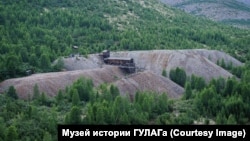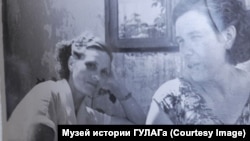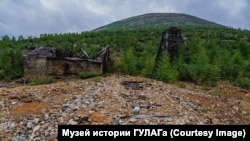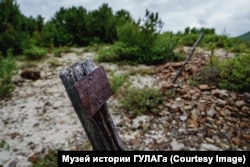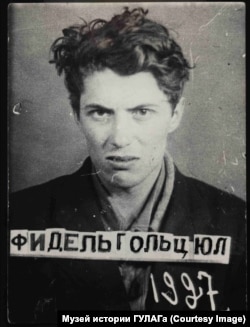Tamara Filatova was 19 years old in 1948 when she was sentenced to 20 years in the gulag for the "crime" of being an ethnic German. Part of her sentence was served at the Dneprovsky labor camp in the brutal Far Eastern mining region known as Kolyma.
She was freed from custody on March 16, 1955, during the wave of de-Stalinization following the death of Soviet dictator Josef Stalin.
"The prosecutor looked at my file and said: 'You were freed in 1953 after Stalin died,'" Filatova recalled in an oral history recorded by the human rights group Memorial. "It turns out I served my last two years as a free person."
Her first thought upon her release was about her mother, who had been exiled to the Qaraghandy region of Kazakhstan.
"I thought I would go there and somehow manage to bring my mother back," Filatova said. "But while I was serving the end of my sentence, she died.... I don't even know where her grave is."
Even after her release, Filatova was not allowed to return to her native Moscow. She settled in Magadan, the regional capital and a transit point for people entering and leaving the Kolyma camps, where she married and gave birth to a son, Pyotr, in 1964.
Blanket Of Silence
"We lived in a barracks in Magadan," Pyotr Filatov told RFE/RL. "All of our neighbors were convicts."
Filatov says the habit of shrouding the crimes of Stalinism under a blanket of silence began in those early times. "During my childhood, political prisoners and criminal prisoners and prison guards all sat together at one table," he recalled. "No one remembered anything. No one hinted at anything or made any reproaches. Because if it had started, it would have been terrible. They would have murdered one another, and what would have been the point?"
Now, however, the Moscow Gulag History Museum and the Memory Foundation have applied to the government of the Magadan region to develop the remains of the Dneprovsky labor camp into an open-air historical complex aimed at preserving the memory of the prisoners who labored and died there under Stalin.
The effort could yet face difficulties, despite initial support from the authorities in Magadan. Under President Vladimir Putin, Stalin's reputation has been gradually rehabilitated and efforts to expose his crimes or remember his millions of Soviet victims have often met resistance.
In 2015, a gulag camp museum in the Perm region was taken over by Kremlin-friendly administrators and the tone of its exhibitions changed noticeably. The site of the first Soviet labor camp, the Far Northern monastery complex of Solovki, has been taken over by the Russian Orthodox Church and reminders of its darker past have been slowly obliterated.
Nonetheless, Gulag History Museum Director Roman Romanov believes it is crucial to push ahead with the effort. "We aren't just talking about the history of Kolyma or even of our country. This is the history of all of humanity," he told RFE/RL. "All over the world people visit places like the Topography of Terror museum in Berlin, where the ruins of the building that housed the Gestapo headquarters are located.... Here in Russia there are very few places where the history of the gulag has not been rewritten or erased."
"But in Kolyma, a lot has been preserved unchanged," he added. It is a unique experience, as are the feelings that you will feel at that moment."
'A Landscape Of Memory'
Dneprovsky is an ideal place to begin such a project, Romanov says. It is the best-preserved labor camp in the region and is located "only" 320 kilometers from Magadan -- closer than some others in the region that sprawls northward from the port city on the Sea of Okhotsk.
Many of the prisoners who were sent there -- like Tamara Filatova, who worked for 17 years as a curator for Memorial before she died in 2017 -- left memoirs with details about daily life there. The technical documentation for the prison buildings and the mines have also been preserved.
"My colleagues and I have done a lot of work over the last few years," Romanov said. "We have photographed the region from the air, taken panoramic photos, made topographical maps, and so on. And now these three layers -- the memoirs, the documents, and the current condition of the camp -- need to be brought together so that Dneprovsky can be a place that tells its own history."
Eventually, Romanov hopes to create a network of important gulag-related sites in Kolyma, including the Butugychag uranium-mining camp and the Mask of Sorrow monument and transit prison in Magadan.
"We need to create a unified infrastructure of memory," Romanov said. "It is a very difficult task since Russia has no experience turning large areas into a museum complex. But if we succeed...we will share the experience with other camps. A major natural-historical space, something like the national parks, could be created. Sort of a landscape of memory."
Romanov says the museum hopes to offer the first excursions to Dneprovsky in the summer of 2021.
Pytor Filatov used to visit the Moscow Gulag History Museum often with his mother before her death. Now he goes there alone.
"I have tried to tell my children what happened to their grandmother," he said. "But they don't want to hear it. It isn't interesting to them. My children and my nieces and nephews -- they know about it, but they don't understand.... I lived my whole life with former prisoners but they haven't experienced that."
'The Face Of Horror'
Mikhail Fidelgolts's father, Yury, served a 10-year sentence in the gulag. Now his mugshot hangs on the wall of the Gulag History Museum.
"Have you seen the photo of him after his arrest?" Fidelgolts asked. "It shows a young, good-looking kid, but his face is completely overshadowed by fear and incomprehension. It is the face of horror."
Yury Fidelgolts was released in May 1954 and fully rehabilitated in 1962.
"Those who went through the camps have a unique way of dealing with people," the younger Fidelgolts recalled. "They aren't open to the world. They are afraid. They do not trust anyone. They are afraid to fall into that grinder again."
"Nonetheless, my father began quite early, as soon as he saw that I was able to understand, telling me about what happened," he added. "For several years, he told me bit by bit. And when I turned 18, he told me everything to the last detail."
Yury Fidelgolts also worked for many years at Memorial and managed to write several books about his experiences in the camps. He died in 2015.
"Even if my children are able to see with their own eyes where and how their grandfather served his time, I don't think they would understand it completely," Mikhail Fidelgolts said when asked about the Kolyma project. "They'd see it was bad and scary, but it is so far from their experience. But creating a museum at the Kolyma camps is necessary and useful nonetheless."
When Romanov thinks of the project now, he remembers the cemeteries there, where graves of prisoners are marked by tiny metal signs clipped from tin cans.
"There is nothing written on them because time has erased the paint," he told RFE/RL. "The descendants of the people buried there -- the grandchildren and great grandchildren -- don't even know where their relatives are buried or how to get there. These cemeteries have to be restored. That is just one more reason why the Kolyma camps must become part of the memorial-museum infrastructure of our country."




